The challenging business landscape of the last few years has brought home the need for organizations to invest in Business Continuity Planning (BCP). A sound business continuity plan includes processes and instructions that organizations should follow during any disaster, whether natural or manmade, to get the business back on its feet and running. BCP holds the key to normalcy when organizations face unplanned disruptions. The need for BCP holds true for interruptions in cloud operations too.
What is disaster recovery?
Any type of unforeseen event that disrupts your business is a disaster. This could be caused by natural disasters, cyber-attacks or human error. Whatever the nature of the disaster, having a clear disaster recovery (DR) plan helps to restore operations to normal quickly. DR involves advance planning and it allows organizations to maintain or quickly restore mission-critical functions following a disaster.
Although both DR and BCP go hand-in-hand, they cannot be considered the same. Disaster recovery focuses on how to quickly get the organization back on its feet after disaster while business continuity deals with how to continue operations smoothly during such events. However, implementing DR plans is a critical part of Business Continuity Planning.
Cloud disaster recovery
A cloud-based disaster recovery plan makes use of a public cloud — such as AWS, Azure or Google Cloud Platform — to back up data, applications and other resources. When disaster strikes, those resources can be restored from the cloud back to their original locations – on premise (on own data centres / co-located data centres) or on cloud, where the backup was stored.
Cloud disaster recovery offers the greatest flexibility and recovery speed compared to other disaster recovery models. An important point to note is that a cloud-based DR plan can be used to back up and restore workloads that run on premise as well as those hosted in the cloud. Organizations do not have to run their production systems in the cloud in order to take advantage of a cloud-based disaster recovery.
Benefits of cloud disaster recovery
Hosting your DR in the cloud has many benefits:
Reduces physical storage needs: DR on the cloud allows you to store your data directly on the cloud, in real time. There is no need to use physical items like disks, tapes, or any other storage devices, which themselves could be compromised in the event of a disaster.
Stores mission-critical data off-site: A cloud DR plan automatically gives you the advantage of keeping your mission-critical data off-site in a remote location, away from your on premise infrastructure. In case of a natural disaster, even if your production centre is fully destroyed, your data will remain safe in a separate location.
Reduces costs: A cloud DR plan is cost-effective. You can pay-as-you-go. In other words, you need to pay for cloud DR infrastructure as and when you use it; there is no need to invest upfront in hardware or to pay for more infrastructure than you actually use at a given time.
Easy to implement and reliable: Implementing your DR site on cloud is easier than other DR models and offers high reliability, more than 99%. This makes DR on cloud a clear winner.
Scalable and efficient: It goes without saying that scaling your infrastructure up and down on cloud is easy and efficient. The entire IT infrastructure of the business can also be lean while fully ready to fight any emergency or disaster.
What about data security?
Security is always a primary concern when it comes to the cloud. Is it really safe to store sensitive personal data on the cloud? While we know that public cloud providers have stringent security protocols in place, some data might still be too sensitive to deploy directly on public clouds – like financial or medical information. Virtual desktops are useful in such cases. Virtual desktops or Desktop-as-a-Service (DaaS) is a solution that helps users get a fast, responsive desktop of their choice accessible anywhere, anytime, from any supported device.
AWS Workspaces and Windows Virtual Desktops are such DaaS services provided by AWS and Microsoft Azure respectively. Virtual Desktops help to eliminate the complexity of managing hardware inventory, OS versions and patches, therefore simplifying your desktop delivery strategy. These Virtual Desktops are deployed within a Virtual Private Network (VPN), providing each user with access to persistent, encrypted storage volumes. No data is stored on the local device but still immediately accessible in case of any eventuality.
The Cloud Kinetics approach
At Cloud Kinetics, we have worked with many clients to design their Cloud Disaster Recovery strategy. We work with key stakeholders during the initial phases to identify and agree on the approach, and follow two basic approaches for Cloud Disaster Recovery:
Approach 1:
- Identify the list of customer stakeholders who can:
- initiate a disaster notification
- approve the need for bringing up the DR region
- approve the need for a DR drill
- Identify and agree on the list of applications, database and other instances that need to be launched
- from the latest snapshot available in the DR region
- Identify and agree on the configuration needed for the listed instances
- Identify and agree on the schedule for copying snapshots of all other instances from the primary region to the DR region
- Setup and perform a DR drill based on the pre-defined schedule.
Approach 2:
- Identify the list of customer stakeholders who can
- initiate a disaster notification
- approve the need for bringing up the DR region
- approve the need for a DR drill
- Identify and agree on the list of applications, database and other instances that need to be running 24×7 in the DR region
- Identify and agree on the configuration needed for the listed instances
- Data replication for DB instances between the primary and DR region
- Identify and agree on the schedule for copying snapshots of all other instances from the primary region to the DR region
- Setup and perform a DR drill based on the pre-defined schedule.
As the world faces unknown threats, having a clear Disaster Recovery Plan in place has become crucial for businesses. Technology has, time and again, offered a solution for most business hurdles. Consequently, a DR plan based on the cloud makes it an ideal cloud disaster recovery solution. Cloud native platforms offer the fast recovery, flexibility, agility, scalability and functionality that an effective DR plan requires.




